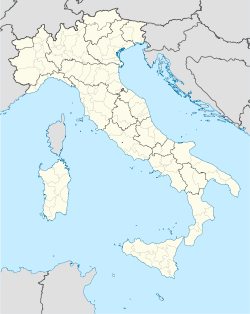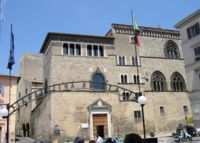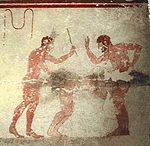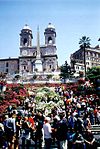- Tarquinia
-
Tarquinia — Comune — Comune di Tarquinia A night view of the Priori Palace. 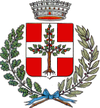
Coat of armsLocation of Tarquinia in Italy Coordinates: 42°14′57″N 11°45′22″E / 42.24917°N 11.75611°E Country Italy Region Lazio Province Viterbo (VT) Frazioni Tarquinia Lido Government – Mayor Mauro Mazzola Area – Total 279.50 km2 (107.9 sq mi) Elevation 132 m (433 ft) Population (May 2010) – Total 16,630 – Density 59.5/km2 (154.1/sq mi) Demonym Tarquiniesi Time zone CET (UTC+1) – Summer (DST) CEST (UTC+2) Postal code 01016 Dialing code 0766 Patron saint Madonna di Valverde Saint day Saturday of May Website Official website Etruscan Necropolises of Cerveteri and Tarquinia * UNESCO World Heritage Site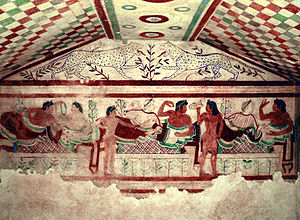
Country Italy Type Cultural Criteria i, iii, iv Reference 1158 Region ** Europe Inscription history Inscription 2004 (28th Session) * Name as inscribed on World Heritage List
** Region as classified by UNESCOTarquinia, formerly Corneto and in Antiquity Tarquinii, is an ancient city in the province of Viterbo, Lazio, Italy.
Contents
History
Tarquinii (Etruscan Tarchnal) is said to have been already a flourishing city when Demaratus of Corinth brought in Greek workmen. It was the chief of the twelve cities of Etruria.[1]
Descendants of Demaratus, Lucius Tarquinius Priscus and Lucius Tarquinius Superbus became kings of ancient Rome. From Tarquinii many of the religious rites and ceremonies of Rome are said to have been derived, and even in imperial times a collegium of sixty haruspices continued to exist there.[1]
In 509 BC, after the overthrow of the Roman monarchy, the family of Tarquinius Superbus went into exile in Caere in Etruria. Tarquin sought to regain the throne, at first by the Tarquinian conspiracy and, when that failed, by force of arms. He convinced the cities of Tarquinii and Veii to support him, and led their armies against Rome in the Battle of Silva Arsia. Although the Roman army was victorious, it is recorded by Livy that the forces of Tarquinii fought well on the right wing, initially pushing back the Roman left wing. After the battle the forces of Tarquinii returned home.[2]
In 358 BC the citizens of Tarquinii captured and put to death 307 Roman soldiers; the resulting war ended in 351 with a forty years' truce, renewed for a similar period in 308. When Tarquinii came under Roman domination is uncertain, as is also the date at which it became a municipality; in 181 BC its port, Graviscae (mod. Porto Clementino), in an unhealthy position on the low coast, became a Roman colony. It exported wine and carried on coral fisheries. Nor do we hear much of it in Roman times; it lay on the hills above the coast road. The flax and forests of its extensive territory are mentioned by classical authors, and we find Tarquinii offering to furnish Scipio with sailcloth in 195 BC. A bishop of Tarquinii is mentioned in 456.[1]
The original site of the Etruscan city of Tarquinia, known as the "Civita", is on the long plateau to the north of the current town. The two coexisted for most of the early Middle Ages, with Tarquinia dwindling to a small fortified settlement on the "Castellina" location, and the more strategically placed Corneto (possibly the "Corito" mentioned in Roman sources) growing progressively to become the major city of the lower Maremma sea coast, especially after the destruction of the port of Centumcellae (modern Civitavecchia). The last historic references to Tarquinia are from around 1250, while the name of Corneto was changed to Tarquinia in 1922. Reversion to historical place names (not always accurately), was a frequent phenomenon under the Fascist Government of Italy as part of the nationalist campaign to evoke past glories.
Tarquinia DOC
The Italian wine DOC of Tarquinia produces red, white frizzante style wine. The grapes are limited to a harvest yield of 12 tonnes/ha with finished wines needing a minimum 10.5% alcohol level. The reds are a blend of at least 60% Sangiovese and/or Montepulciano, up to 25% Cesanese and up to 30% of other local red grape varieties. The whites are composed of at least 50% Trebbiano and/or Giallo, up to 35% Malvasia and up to 30 other local grape varieties with the exception of Pinot grigio that is specifically excluded from the DOC wines of Tarquinia.[3]
Main sights
- The Etruscan necropolises, with some 6,000 tombs, 200 of which include wall paintings. The main site is the Necropolis of Monterozzi, with a large number of tumulus tombs with chambers carved in the rock. The scenes painted include erotical and magic depictions, landscapes, dances and music. There are also carved sarcophagi, some dating to the Hellenistic period. Main tombs included the Tomba della Fustigazione and the Tomb of the Leopards.
- Remains of the Ara della Regina ("Altar of the Queen") temple, measuring c. 44 x 25 m and dating to c. 4th-3rd century BC. IT was built in tuff with wooden structures and decorations. Also traces of the Etruscan walls (c. 8th century BC) exist: they had a length of some 8 km.
- The National Museum, with a large collection of archaeological findings. It is housed in the Renaissance Palazzo Vitelleschi, begun in 1436 and completed around 1480-1490
- Church of Santa Maria di Castello (1121–1208), with Lombard and Cosmatesque influences. The façade has a small bell-tower and three entrances. The interior has a nave and two aisles, divided by massive pilasters with palaeo-Christian capitals and friezes. Noteworthy are also the rose-window in the nave and the several marble works by Roman masters.
- The Cathedral, once in Romanesque-Gothic style but rebuilt after the 1643 fire, has maintained from the original edifice the 16th century frescoes in presbitery, by Antonio del Massaro.
- Church of San Giacomo and Santissima Annunziata, showing different Arab and Byzantine influences.
- The small church of San Martino (12th century).
- The church of St. John the Baptist (12th century), with an elegant rose-window in the simple façade.
- The Communal Palace, in Romanesque style, begun in the 13th century and restored in the 16th.
- The numerous medieval towers, including that of Dante Alighieri.
- The Palazzo dei Priori. The façade, remade in Baroque times, has a massive external staircase. The interior has a fresco cycle from 1429.
- The Gothic-Romanesque church of San Pancrazio.
Twin towns
References
 This article incorporates text from a publication now in the public domain: Thomas Ashby (1911). "Tarquinii". In Chisholm, Hugh. Encyclopædia Britannica (11th ed.). Cambridge University Press. This work in turn cites:
This article incorporates text from a publication now in the public domain: Thomas Ashby (1911). "Tarquinii". In Chisholm, Hugh. Encyclopædia Britannica (11th ed.). Cambridge University Press. This work in turn cites:
- L. Dasti, Notizie storiche archeologiche di Tarquinia e Corneto (Rome, 1878)
- G. Dennis, Cities and Cemeteries of Etruria (London, 1883), i. 301 sqq.
- Notizie degli Scavi, passim, especially 1885, 513 sqq.
- E. Bormann in Corp. Inscr. Lai., xi. (Berlin, 1888), p. 510 sqq.
- G. Körte, “Etrusker” in Pauly-Wissowa, Realencyklopädie, vi. 730 sqq.
External links
- Official website
- Awayaway.com, Tarquinia - ancient history of Italy: descriptions of some Etruscan tombs
- Uchicago.edu (3 chapters of George Dennis's Cities and Cemeteries of Etruria)
- Discoversoriano.com, Information about Tarquinia's Cattle Branding Festival
 "Corneto". Encyclopaedia Britannica. 6 (9th ed.). 1878.
"Corneto". Encyclopaedia Britannica. 6 (9th ed.). 1878. "Corneto Tarquinia". Encyclopædia Britannica (11th ed.). 1911.
"Corneto Tarquinia". Encyclopædia Britannica (11th ed.). 1911.
Lazio · Comuni of the Province of Viterbo Acquapendente · Arlena di Castro · Bagnoregio · Barbarano Romano · Bassano Romano · Bassano in Teverina · Blera · Bolsena · Bomarzo · Calcata · Canepina · Canino · Capodimonte · Capranica · Caprarola · Carbognano · Castel Sant'Elia · Castiglione in Teverina · Celleno · Cellere · Civita Castellana · Civitella d'Agliano · Corchiano · Fabrica di Roma · Faleria · Farnese · Gallese · Gradoli · Graffignano · Grotte di Castro · Ischia di Castro · Latera · Lubriano · Marta · Montalto di Castro · Monte Romano · Montefiascone · Monterosi · Nepi · Onano · Oriolo Romano · Orte · Piansano · Proceno · Ronciglione · San Lorenzo Nuovo · Soriano nel Cimino · Sutri · Tarquinia · Tessennano · Tuscania · Valentano · Vallerano · Vasanello · Vejano · Vetralla · Vignanello · Villa San Giovanni in Tuscia · Viterbo · Vitorchiano
Etruscan-related topics History Origin · Founding of Rome · Tyrrhenus · Tyrrhenians · Tarchon · Capys · Lucius Tarquinius Priscus · Tanaquil · Lucius Tarquinius Superbus · Lars Porsena · Servius Tullius · Lars Tolumnius · Caelius Vibenna · Etruscan League · Titus Vestricius Spurinna · Vicus Tuscus · Aruns (son of Tarquinius Superbus) · Raeti · Poppilia
Culture Tages · Vulca · Persius · Titus Larcius · Art · Architecture · Terracotta warriors · Coins · Apollo of Veii · Chimera of Arezzo · Corpus Speculorum Etruscorum · Tomb of the Roaring Lions · Sarcophagus of the Spouses · Jewelry · Society · Religion · Mythology · Mythological figures · Etruscan Sibyl · Haruspex · Liver of Piacenza · Etruscan names for Greek heroes · Fanum Voltumnae · Mezentius · Lausus · ExtispicyWarfare Language Tyrsenian languages · Alphabet · English words of Etruscan origin · Spanish words of Etruscan origin · Lemnian language · Rhaetic language · Pyrgi Tablets · Cippus perusinus · Liber Linteus · Corpus Inscriptionum Etruscarum · Tabula Capuana · Tabula CortonensisArcheology Key sites Etruria · Volsinii · Clusium · Aleria · Caere · Populonia · Baratti · Perusia · Spina · Norchia · Veii · Fidenae · Falerii · Ceri · Adria · Bologna · Cumae · Pyrgi · Volterra · Acquarossa · Rusellae · Civita di Bagnoregio · Tarquinia · Fescennia · Orvieto · Poggio Colla · San Giovenale · Tuscania · VetuloniaCategories:- Cities and towns in Lazio
- Communes of the Province of Viterbo
- Etruscan sites
- World Heritage Sites in Italy
Wikimedia Foundation. 2010.


